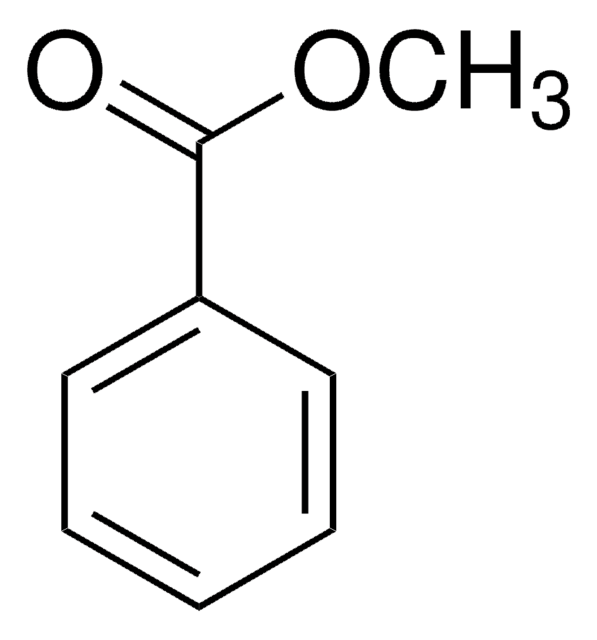32213
Methanol
≥99.8% (GC), ACS reagent, suitable for immunofluorescence, reag. Ph. Eur., reag. ISO, USP/NF
Synonym(s):
Methyl alcohol
About This Item
97.68 mmHg ( 20 °C)
Recommended Products
Product Name
Methanol, puriss. p.a., ACS reagent, reag. ISO, reag. Ph. Eur., ≥99.8% (GC)
grade
ACS reagent
puriss. p.a.
Quality Level
Agency
USP/NF
reag. ISO
reag. Ph. Eur.
vapor density
1.11 (vs air)
vapor pressure
410 mmHg ( 50 °C)
97.68 mmHg ( 20 °C)
Assay
≥99.8% (GC)
form
liquid
autoignition temp.
725 °F
expl. lim.
36 %
technique(s)
immunofluorescence: suitable
impurities
≤0.00005% free alkali (as NH3)
≤0.0001% formaldehyde
≤0.00025% KMnO4 red. matter (as O)
≤0.0005% non-volatile matter
≤0.001% acetaldehyde
≤0.001% acetone (GC)
≤0.05% water (Karl Fischer)
≤0.1% ethanol (GC)
refractive index
n20/D 1.329 (lit.)
bp
64.7 °C (lit.)
mp
−98 °C (lit.)
density
0.791 g/mL at 25 °C (lit.)
anion traces
chloride (Cl-): ≤0.5 mg/kg
sulfate (SO42-): ≤1 mg/kg
cation traces
Al: ≤0.5 mg/kg
B: ≤0.02 mg/kg
Ba: ≤0.1 mg/kg
Bi: ≤0.1 mg/kg
Ca: ≤0.5 mg/kg
Cd: ≤0.05 mg/kg
Co: ≤0.02 mg/kg
Cr: ≤0.02 mg/kg
Cu: ≤0.01 mg/kg
Fe: ≤0.1 mg/kg
K: ≤0.5 mg/kg
Li: ≤0.1 mg/kg
Mg: ≤0.1 mg/kg
Mn: ≤0.01 mg/kg
Mo: ≤0.1 mg/kg
Na: ≤0.5 mg/kg
Ni: ≤0.02 mg/kg
Pb: ≤0.02 mg/kg
Sn: ≤0.1 mg/kg
Sr: ≤0.1 mg/kg
Zn: ≤0.1 mg/kg
SMILES string
CO
format
neat
InChI
1S/CH4O/c1-2/h2H,1H3
InChI key
OKKJLVBELUTLKV-UHFFFAOYSA-N
Looking for similar products? Visit Product Comparison Guide
Related Categories
General description
Application
- Colony forming unit-fibroblast assay of bone marrow mononuclear cells.
- As solvent for the preparation of extracts of hyphae of Aspergillus for the estimation of gliotoxin by reversed phase-HPLC.
- Immunofluorescence studies.
Packaging
Other Notes
The article number 32213-4X2.5L-M will be discontinued. Please order the single bottle 32213-2.5L-M which is physically identical with the same exact specifications.
The article number 32213-4X5L will be discontinued. Please order the single bottle 32213-5L which is physically identical with the same exact specifications.
The article number 32213-6X1L will be discontinued. Please order the single bottle 32213-1L which is physically identical with the same exact specifications.
Signal Word
Danger
Hazard Statements
Precautionary Statements
Hazard Classifications
Acute Tox. 3 Dermal - Acute Tox. 3 Inhalation - Acute Tox. 3 Oral - Flam. Liq. 2 - STOT SE 1
Target Organs
Eyes,Central nervous system
Storage Class Code
3 - Flammable liquids
WGK
WGK 2
Flash Point(F)
49.5 °F - closed cup
Flash Point(C)
9.7 °C - closed cup
Choose from one of the most recent versions:
Already Own This Product?
Find documentation for the products that you have recently purchased in the Document Library.
Customers Also Viewed
Our team of scientists has experience in all areas of research including Life Science, Material Science, Chemical Synthesis, Chromatography, Analytical and many others.
Contact Technical Service





